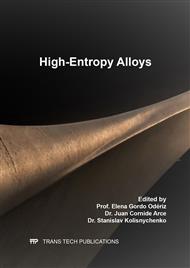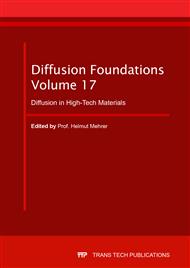[1]
J.-W. Yeh, JOM, 65 1759 (2013).
Google Scholar
[2]
B. Murty, J.-W. Yeh, S. Ranganathan, High-entropy Alloys, Butterworth-Heinemann, (2014).
Google Scholar
[3]
Y. Zhang, J.-W. Yeh, J.F. Sun, J.P. Lin, K.-F. Yao, Adv. Mater. Sci. Eng. 2015 (2015) 1.
Google Scholar
[4]
H.K.D.H. Bhadeshia, Mater. Sci.Technol. 31 1139 (2015).
Google Scholar
[5]
Y. Zhang, T.T. Zuo, Z. Tang, M.C. Gao, K.A. Dahmen, P.K. Liaw, Z.P. Lu, Prog. Mater. Sci. 61 1 (2014).
Google Scholar
[6]
Z. An, H. Jia, Y. Wu, P.D. Rack, A.D. Patchen, Y. Liu, Y. Ren, N. Li, P.K. Liaw, MATER. RES. LETT. 3 203 (2015).
Google Scholar
[7]
C.-J. Tong, Y.-L. Chen, J.-W. Yeh, S.-J. Lin, S.-K. Chen, T.-T. Shun, C.-H. Tsau, S.-Y. Chang, Metall. Mater. Trans. A36 881 (2005).
Google Scholar
[8]
D.B. Miracle, O.N. Senkov, Acta Mater. 122 448 (2017).
Google Scholar
[9]
K.Y. Tsai, M.H. Tsai, J.W. Yeh, Acta Mater. 61 4887 (2013).
Google Scholar
[10]
K. Kulkarni, G.P.S. Chauhan, AIP Adv. 5 97162 (2015).
Google Scholar
[11]
D.L. Beke, G. Erdélyi, Mater. Lett. 164 111 (2016).
Google Scholar
[12]
M. Zajusz, J. Dabrowa, M. Danielewski, Scr. Mater. 138 48 (2017).
Google Scholar
[13]
M. Vaidya, S. Trubel, B.S. Murty, G. Wilde, S.V. Divinski, J. Alloy. Compd. 688 994 (2016).
Google Scholar
[14]
A. Paul, Philos. Mag. 93 2297 (2013).
Google Scholar
[15]
A. Paul, Scr. Mater. 135 153 (2017).
Google Scholar
[16]
K.Y. Tsai, M.H. Tsai, J.W. Yeh, Scr. Mater. 135 158 (2017).
Google Scholar
[17]
A.R. Allnatt, T.R. Paul, I.V. Belova, G.E. Murch, Philos. Mag. 96 2969 (2016).
Google Scholar
[18]
T.R. Paul, I.V. Belova, G.E. Murch, Mater. Chem. Phys. 210 301 (2018).
Google Scholar
[19]
M. Vaidya, K.G. Pradeep, B.S. Murty, G. Wilde, S.V. Divinski, Sci. Rep. 7 12293 (2017).
Google Scholar
[20]
J. Dabrowa, W. Kucza, G. Cieslak, T. Kulik, M. Danielewski, J.W. Yeh, J. Alloy. Compd. 674 455 (2016).
Google Scholar
[21]
C. Zhang, F. Zhang, K. Jin, H. Bei, S. Chen, W. Cao, J. Zhu, D. Lv, J Phase Equilib Diffus. 38 434 (2017).
Google Scholar
[22]
K. Jin, C. Zhang, F. Zhang, H. Bei, MAT. RES. LETT. 6 293 (2018).
Google Scholar
[23]
M. Vaidya, K.G. Pradeep, B.S. Murty, G. Wilde, S.V. Divinski, Acta Mater. 146 211 (2018).
Google Scholar
[24]
J.R. Manning, Phys. Rev. B4 1111 (1971).
Google Scholar
[25]
S. Rothman, L. Nowicki, G. Murch, J. Phys. F Met. 10 383 (1980).
Google Scholar
[26]
D. L. Beke, G. Erdélyi, F. J. Kedves, J of Phys Chem Sol. 42 163 (1981).
Google Scholar
[27]
D.L. Beke, Def. and Diff. Forum 66-69 172 (1989).
Google Scholar
[28]
D.L. Beke. Def. and Diff. Forum 83 31 (1992).
Google Scholar
[29]
J. de Boer, J., Physica XIV 139 (1948).
Google Scholar
[30]
T. Geszti, Phys. Letters 29A 425 (1969).
Google Scholar
[31]
C. Domb, Suppl. Il Nuovo Cimento IX, 9 (1958).
Google Scholar
[32]
C. Zener, J. Appl. Phys. 22 327 (1951).
Google Scholar
[33]
J.O. Hirschfelder, C.F., Curtis, R.B., Bird: Molecular Theory of Gases and Liquids,, John Wiley, New York, (1954).
Google Scholar
[34]
C.M Focken: Dimensional Methods and their Applications,, Edward Arnold and Co., London, (1953).
Google Scholar
[35]
A.D. Le Claire, in Diffusion in bcc metals,, American Society for Metals, Ohio, 1965, p.7.
Google Scholar
[36]
G.J. Dienes, J Appl. Phys. 21 1189 (1950).
Google Scholar
[37]
D.L. Beke. T. Geszti, G. Erdélyi, Z. Metallkde. 68 (1977) 445.
Google Scholar
[38]
D.L. Beke, F.J. Kedves, Z. Metallkde. 74 (1983) 239.
Google Scholar
[39]
D.L. Beke, I. Gödény, F.J Kedves, J Phys. Chem. Sol. 40 543 (1979).
Google Scholar
[40]
X. Yang, Y. Zhang, Mater. Chem. Phys. 132 233 (2012).
Google Scholar
[41]
D.L. Beke, I. Uzonyi, F.J. Kedves, Philos. Mag. A44 983 (1981).
Google Scholar
[42]
G. Erdélyi, D. L. Beke, F.J. Kedves, I. Gödény, Phil. Mag. B38 (1978) 445.
Google Scholar
[43]
D. L. Beke, I. Gödény, I. A. Szabó, G. Erdélyi, F. J. Kedves, Phil. Mag. A55 (1987) 425.
Google Scholar



